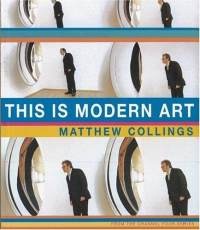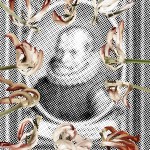Carolus Clusius is at the root of my present problem - can't let go of…
We don’t let them out
Reading ‘this is modern art’ by Matthew Collings at the moment. Despite it’s pretentious title, it’s quite good! Irreverent, funny, a thematic approach that avoids the art historian’s summations altogether, which is refreshing. Chapter 1: I am a Genius, Chapeter 5: Hollow Laughter, to give but a few examples. A heavvy emphasis on the UK and USA, which is to be expected since Collings is ” a British art critic, writer, broadcaster, and artist” (wiki).
Took the book with me on my train ride to Utrecht this morning – I am babysitting a class of project managers doing a Prince2 exam – and chapter 5 had me laughing out loud Which is quite something, as I am famously moody in the mornings. And the dutch railway system is no help in cheering me up.
A quote from the Hollow Laughter chapter (page 214), where Collings writes about the jokey character of much of Martin Kippenberger’s work: “We might be flicking through No Problem, his [Kippenbergers] book of thoughts, including his thoughts on identity crisis, alcoholism and chocolate mousse. ‘We don’t have problems with the Rolling Stone,’ one of the thoughts goes, ‘because we buy their guitars.’ We don’t have problems with people who look just like us because they feel our pain. We don’t have problems with the Guggenheim because we can’t say no if we’re not invited. We don’t have problems with disco door waiters because if they don’t let us in we don’t let them out. “
Nice, no? Have to finish the book in a hurry as it is due back at OBA, the public library in Amsterdam where I am a very very happy member. It is not all fun and games, though:
Chapter 6 : The Shock of the Now, page 225: Hi! You’re here. And it’s now. And soon it will be the end. Let’s sort out all the anxieties of now in then thousand words. That’s already 25. Twenty-eight now. Phew, it’s hard to conceptualize time! Why do we have to conceptualize anything, is one of the main anxieties that society has about the art of now. Within art there are many anxieties too, because art expresses the anxieties of the society among other things. But it rarely expresses the main one directly, that art is vacuous now.
vac·u·ous [vak-yoo-uhs]
adjective
1. without contents; empty: the vacuous air.
2.lacking in ideas or intelligence: a vacuous mind.
3. expressing or characterized by a lack of ideas or intelligence; inane; stupid: a vacuous book.
4. purposeless; idle: a vacuous way of life.
Origin: 1645–55; < Latin vacuus empty; see -ous
This answer exists just as strongy nowadays as the impression that art has suddenly become incredibly popular and full of significance and meanings, whereas before it was unpopular and only had introverted meanings. One is superimposed over another; an anxiety over an impression. Or there is a sequential relationship: the more popular art gets the more vacuous it is. Or one is inside of the other.
Relatively recently the assumption was that there was no point in thinking about contemporary art because it didn’t mean anything to anyone exept artists and you could easily live your life without it. Now there is a growing anxiety that there might not be any point to it because its meanings are too available and also to available elsewhere, in ads, rock, video,crappy moronic blockbuster films, on the Internet, and so forth. As art draws evn closer to maximum immediate impact it becomes less valued. Films and ads are better because at least you know where you are with them. In hell, probably, or in a Salvador Dali painting.
When art is about ideas and not about aesthetics or loveliness or inner spiritual depths – well, OK, when it’s about ideas, let’s keep it simple – how do you tell a good idea from a bad one? The audience for art now feels suspicious because it suspects there isn’t a hierarchy – it’s just an anything goes ethos, and that makes the audience feel it is being fooled. It isn’t necessary furious about being fooled. It just takes it for granted that fooling is occurring. Therefore the Turner prize, for example,is an amusing talking-point, a laugh on the cultural calendar, but not an outrage. It is important because culture is part of amusement and part of what makes dinner parties tick. But also not important because it is felt that the art is unimportant.
The main anxiety of now is that art is vacuous. Consequently there is an exaggerated and perhaps unrealistic respect for old Modern artists like Chagall, where you could judge for yourself if it’s good. Today art is popular and there are lots of new Modern art museums opening up all the time. But the audience feels they could easily think up a lot of this stuff themselves and it would fit the bill providing it was empty, shocking, sexual and a bit pretentious. And that makes them despise it even if they enjoy it as a kind of circus.
When art is a little pile of burned cocaine by Cornelia Parker, you can’t tell if it’s successful or not. You want to be able to say you’ve praised something that seems to be fairly rich. And when something seems vacuous, you want to dislike it on the grounds of being vacuous. But the system won’t allow this.








